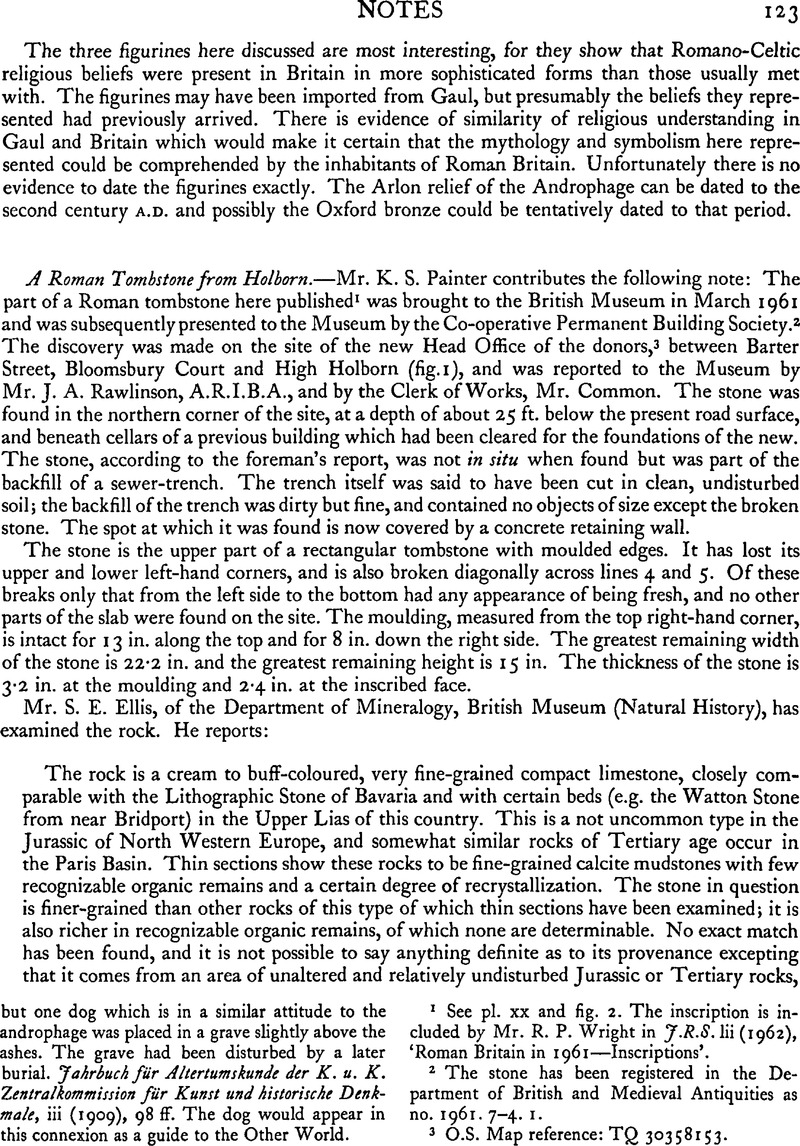No CrossRef data available.
Article contents
A Roman Tombstone from Holborn
Published online by Cambridge University Press: 29 November 2011
Abstract

- Type
- Notes
- Information
- Copyright
- Copyright © The Society of Antiquaries of London 1963
References
page 123 note 1 See pl. xx and fig. 2. The inscription is included by Mr.Wright, R. P. in J.R.S. lii (1962), ‘Roman Britain in 1961—Inscriptions’Google Scholar.
page 123 note 2 The stone has been registered in the Department of British and Medieval Antiquities as no. 1961. 7–4. 1.
page 123 note 3 O.S. Map reference: TQ 30358153.
page 124 note 1 R.C.H.M., Roman London (1928), p. 165Google Scholar: ‘an urn in grey ware with “rustication” in low relief.’ Now in the London Museum, no. L.M. A 1705.
page 124 note 2 R.C.H.M., Roman London (1928), p. 165Google Scholar, P.S.A., 2nd ser., ii, p. 376: a cylindrical leaden cist containing burnt bones and 2 denarii of Vespasian, from the site of Messrs. Watney, Combe, Reid & Co.'s former brewery, to the south of New Oxford Street. The cist (Reg. no. 1864. 3–22. 1) and coins are now in the British Museum.
page 125 note 1 R.C.H.M., Roman London, p. 164.
page 125 note 2 For the use of an adjective to indicate the town of origin Cagnat, R., Cours d'épigraphie iatine 3 (1898), p. 63Google Scholar, cites CIL ii, 4205: ‘L. Clodio M. f(ilio), Vel(ina tribu), Ingenuo Pa[l]mensi’.
page 125 note 3 The conjecture has been accepted by Mr. R. P. Wright; v. supra, p. 123, note I. Professor Richmond suggested the layout of the lettering adopted in the drawing.
page 125 note 4 Pauly–Wissowa, , Realencyclopädie, vol. ii A, pt. ii, col. 2097Google Scholar, using Dean, L. R., ‘A Study of the Cognomina of Soldiers of the Roman Legions’, Dissertation, Princeton, N.J., 1916Google Scholar.
page 125 note 5 I owe this point to Professor Birley.
page 125 note 6 v. Festus ep. p. 33: ‘beneficiarii dicebantur, qui vacabant muneribus beneficio’; Vegetius 2, 7: ‘beneficiarii ab eo appellati, quod promovebantur beneficio tribuni’; von Domaszewski, A., ‘Die Rangordnung des römischen Heeres’, in Bonner Jahrbücher, cxvii (1908), 4Google Scholar; Jones, A. H. M., Studies in Roman Government and Law, Blackwell, 1960, pp. 161 ffGoogle Scholar.
page 125 note 7 Caesar, B.C., i, 75, iii, 88.
page 125 note 8 A. H. M. Jones, loc. cit.
page 125 note 9 Domaszewski, Von, op. cit., p. 29Google Scholar.
page 125 note 10 CIL viii, 2551 and von Domaszewski, op. cit., p. 29.
page 125 note 11 CIL xiv. 3955 = ILS 2740.
page 125 note 12 I owe this point to Professor Birley. V. G. Wesenberg, PW xxiii (1957), cols. 1274–8, s.v. ‘procurator’.
page 125 note 13 CIL iii, 11233.
page 125 note 14 Ephemeris epigraphica, iii, 232.
page 125 note 15 Abhandlungen des archaeologisch-epigraphischen Seminares der Universität Wien, Heft 3, ‘De Romanarum Tribuum Origine ac Propagatione, (Wien, 1882), p. 200Google Scholar.
page 126 note 1 Arch. Journal, ciii (1946), 70Google Scholar, discussing the inscription M. Ulpio Ner. Quinto Glevi (CIL vi, 3346=ILS 2365) and referring to Mommsen's discussion (CIL x, 12) of the evidence showing that colonies founded or refounded by Nerva were called Nervia or Nerviana.
page 126 note 2 Camulodunum, Research Report of the Society of Antiquaries No. xiv (1947), p. 8.
page 126 note 3 PW vi (1899), s.v. ‘Camulodunum’.
page 126 note 4 Discussing the year A.D. 69 Tacitus (Histories, ii, 11) says: ‘praecipui fama quartadecumani rebellione Britanniae compressa. Addiderat gloriam Nero eligendo ut potissimos.’ The earliest reference to the full title of the legion occurs on the tombstone, dated to A.D. 66, of M. Vettius Valens (CIL xi, 395).
page 127 note 1 Ritterling (PW xxiv, cols. 1771, 1775–6, 1780, s.v. ‘Legio XX Valeria Victrix’) did not choose between the defeat of the Illyrians in A.D. 6 and the defeat of Boudicca in A.D. 61.
page 127 note 2 Annals, xiv, 27, 4, commenting on Nero's grant of colonial privileges to Puteoli and his reinforcement of Tarentum and Antium. As Professor Syme notes (Tacitus (1958), 447Google Scholar), a colonia of 3,000 legionaries conducted by a primipilaris was probably established at Cyrene in the last year of Trajan (v. J.R.S. xl (1950), 84Google Scholar); but this was half a century later than the period about which Tacitus was writing.
page 127 note 3 loc. cit.
page 127 note 4 CIL xiv, 3955. V. supra.
page 127 note 5 CIL iii, 660, from Philippi in Macedonia, seems to refer to a man who had been something at colo(ni)ae Vict(ric)ensium. That he was also flamen divi Vespasiani gives a terminus post quern.
page 127 note 6 See the list in PW iv (1901), cols, 527 ff., s.v. Coloniae: Tarraco—Colonia Iulia Victrix Triumphalis Tarraco; Carthagonova—colonia Iulia Victrix Nova Carthago; Celsa—colonia Iulia Victrix Celsa; Baeterrae—colonia V(ictrix?) Iulia Septimanorum.
page 127 note 7 On the origins of Claudius’ policy v. Sherwin-White, A. N., The Roman Citizenship, Oxford, 1939, pp. 181 ffGoogle Scholar.
page 127 note 8 v. Sherwin-White, op. cit., pp. 187 f. In Gaul: Vienna; colonia Vellavorum; colonia Treverorum; colonia Sequanorum; colonia Lingonum.
page 127 note 9 v.Mommsen, T., Römisches Staatsrecht, ii, 889Google Scholar.
page 128 note 1 Cf. the warning of Thylander, H., Étude sur l'épigraphie latine (Skrifter utgivna av Svenska Institutet i Rom—Acta Instituti Romani Regni Sueciae), Lund, 1952, pp. 40–48.Google Scholar On a specific point, R. P. Wright, loc. cit., demonstrates that ligatures in themselves cannot be used to date Roman inscriptions from Britain.
page 128 note 2 v.Thylander, , op. cit., pp. 50–51Google Scholar.
page 128 note 3 I must thank particularly Professor E. Birley, Mr. S. S. Frere and Mr. R. P. Wright for their considerable help. The drawings are by Miss M. O. Miller.


